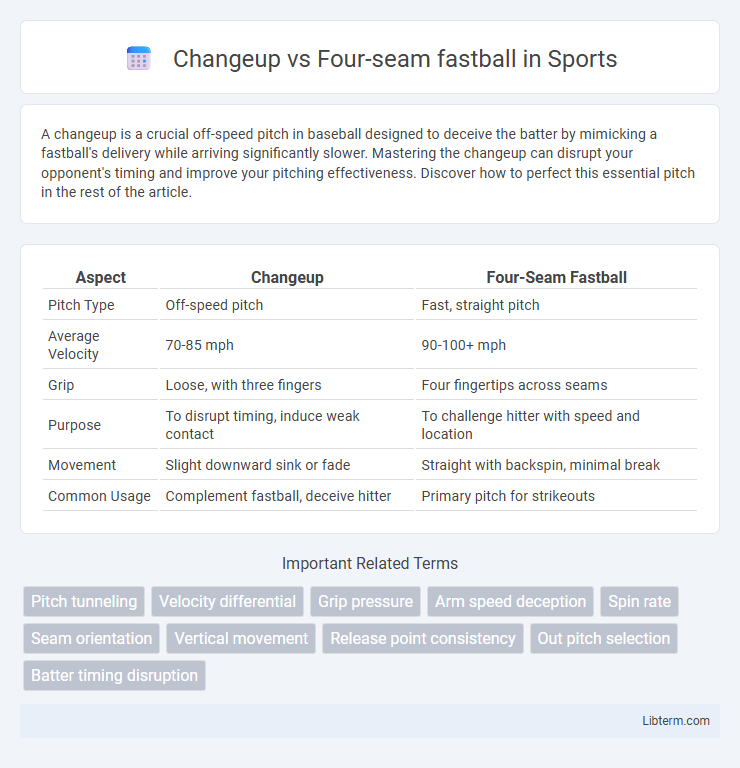A changeup is a crucial off-speed pitch in baseball designed to deceive the batter by mimicking a fastball's delivery while arriving significantly slower. Mastering the changeup can disrupt your opponent's timing and improve your pitching effectiveness. Discover how to perfect this essential pitch in the rest of the article.
Table of Comparison
| Aspect | Changeup | Four-Seam Fastball |
|---|---|---|
| Pitch Type | Off-speed pitch | Fast, straight pitch |
| Average Velocity | 70-85 mph | 90-100+ mph |
| Grip | Loose, with three fingers | Four fingertips across seams |
| Purpose | To disrupt timing, induce weak contact | To challenge hitter with speed and location |
| Movement | Slight downward sink or fade | Straight with backspin, minimal break |
| Common Usage | Complement fastball, deceive hitter | Primary pitch for strikeouts |
Introduction to Pitching: Changeup vs Four-Seam Fastball
The four-seam fastball is a high-velocity pitch characterized by its straight trajectory and backspin, typically thrown between 90-100 mph, designed to overpower hitters. The changeup, delivered at a slower speed around 70-85 mph with similar arm action to the fastball, disrupts the batter's timing by mimicking the fastball's arm speed while reducing velocity. Mastery of both pitches is essential for pitchers aiming to control the strike zone and keep hitters off balance through velocity differential and pitch sequencing.
Defining the Changeup: Features and Technique
The changeup is a slower pitch designed to mimic the arm action of a four-seam fastball, deceiving the batter by disrupting timing. It features a looser grip and a slower release, typically 8-15 mph slower than the four-seam fastball, creating reduced velocity while maintaining similar arm speed. Pitchers use a circle or three-finger grip to generate minimal spin and greater downward movement, enhancing its effectiveness against fast hitters.
Understanding the Four-Seam Fastball
The four-seam fastball is a high-velocity pitch characterized by its straight trajectory and maximum backspin, generating minimal air resistance and increased lift for improved control and speed. Unlike the changeup, which relies on reduced velocity and deception, the four-seam fastball emphasizes power and precision to overpower hitters. Mastery of grip and release mechanics is crucial for pitchers to optimize fastball effectiveness and maintain consistent arm action.
Key Differences in Grip and Release
The changeup features a looser grip with three fingers across the seams, reducing velocity while maintaining deceptive arm speed. In contrast, the four-seam fastball uses a tighter grip with fingers perpendicular to the seams for maximum backspin and velocity. The release of a changeup involves a pronated wrist motion to slow the pitch, whereas the four-seam fastball release emphasizes a strong, overhand snap to generate velocity and straight trajectory.
Velocity Comparison: Changeup vs Four-Seam Fastball
The four-seam fastball typically reaches velocities between 90 to 100 mph, making it one of the fastest pitches in baseball, while the changeup generally ranges from 70 to 85 mph, designed to mimic the fastball's arm action but with significantly reduced speed. This velocity difference, often 8 to 15 mph slower on the changeup, disrupts a batter's timing and creates an effective off-speed contrast. Pitchers leverage this gap in speed to deceive hitters, enhancing the changeup's strategic value despite its lower velocity compared to the four-seam fastball.
Movement and Ball Trajectory Analysis
The changeup features significantly more downward and horizontal movement compared to the four-seam fastball, resulting in a deceptive drop that disrupts a hitter's timing. The four-seam fastball follows a straighter, more direct trajectory with backspin generating consistent lift, maintaining a higher velocity and a relatively stable flight path. Analyzing ball trajectory data reveals that changeups tend to have lower spin rates and increased pitch tunneling effects, making them effective for inducing weak contact and swings-and-misses.
Strategic Uses in Game Situations
The changeup and four-seam fastball serve distinct strategic purposes in baseball pitching. The four-seam fastball is often utilized to challenge hitters with maximum velocity and pinpoint control, setting up strikeouts or weak contact early in counts. In contrast, the changeup disrupts timing by mimicking fastball arm speed but arriving significantly slower, making it effective against aggressive hitters and inducing ground balls or swings and misses in crucial situations.
Effects on Hitters: Timing and Perception
The changeup disrupts hitters' timing by mimicking the four-seam fastball's arm action while significantly reducing velocity, often resulting in late swings or weak contact. The four-seam fastball challenges hitters with its consistent, high velocity and straight trajectory, demanding quick reaction times and precise timing. This contrast in velocity and perceived pitch speed between the two pitches creates uncertainty, enhancing the pitcher's effectiveness.
Notable Pitchers Known for Each Pitch
Notable pitchers known for their changeup include Pedro Martinez and Johan Santana, who used the pitch to disrupt hitters' timing with its deceptive velocity and movement. In contrast, pitchers like Justin Verlander and Gerrit Cole have excelled with their four-seam fastball, leveraging its high velocity and straight trajectory to overpower batters. Each pitch plays a key role in the distinctive pitching arsenal that defines these elite pitchers' effectiveness on the mound.
Choosing the Right Pitch: Factors for Success
Choosing the right pitch between a changeup and a four-seam fastball depends on factors such as batter tendencies, game situation, and pitcher's arm speed consistency. A changeup disrupts timing by mimicking a fastball's delivery with reduced velocity, ideal against aggressive hitters anticipating fastballs. Meanwhile, the four-seam fastball offers maximum velocity and control, making it effective when accuracy and power are needed to challenge hitters.
Changeup Infographic

 libterm.com
libterm.com